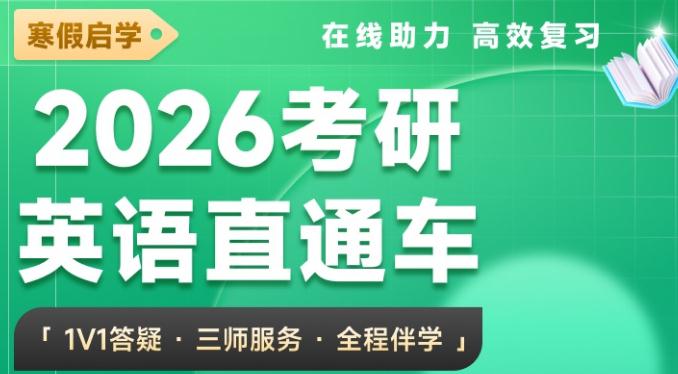1998-2022 ChinaKaoyan.com Network Studio. All Rights Reserved. 沪ICP备12018245号
2013年考研英语阅读必备技巧
考研英语阅读是考研英语所有题型中的重中之重,所谓“得阅读者得天下”。如何做好阅读题对很多同学来说都是一件很头疼的事。其实,只要掌握一些必备的技巧,考研英语阅读也是不难攻破的。下面就来给大家支几招。
一、答题顺序的技巧
考研英语阅读理解题每篇有五个选项,一般情况下五个题目的顺序是按照文章的顺序逐段出题,两者是对应的,偶有跳段的情况,但是先后顺序基本不变。比较例外的是文章主旨题,大部分的主旨句是在文章末端才出现,或者文章开始的主旨句恰好是文章要驳斥的观点,所以需要考生通读全文才能解答。具体答题顺序有如下三种:
(1)从面到点,先通读文章后看题,不清楚再回头去读有关段落。优点:一开始就对文章有一个总的概念和印象。缺点:速度慢,读起来没有重点,做题时对文章细节记不清楚。
(2)从点到面,先看问题后浏览文章,带着问题的记忆去文章中找答案。优点:针对性强、速度快,无关的内容可以省略不读,与问题很可能有关的内容则可重点标出。缺点:开始时没有对文章的整体把握。
(3)点面交叉,读一层意思做数道题,阅读和做题交叉进行。优点:速度适中,比较有针对性,对刚读完的内容印象深。因为全文最重要的部分在首段和各段首句,用这种方法也可以对文章的轮廓有初步的了解。
总结:任何方法都不是绝对的,考生可根据自己的个性与思维习惯以及具体的题目情况灵活处理。像段落主旨题、词义/句意题、事实细节题这些局部问题可以采用从点到面的方法,而主旨题、作者态度/观点题、引申推理题因为就全文提问或考上下文逻辑关系则需要从面到点。然而命题者出于对难易平衡的考虑,基本上会保证每篇都有一道至两道全局性问题。所以考生可以考虑点面交叉的方法。
二、跳读的技巧
考研阅读的文章都很长,读起来会浪费不少时间,如下内容是可以跳读的:
(1)有关职务、头衔、社会地位等补充性说明;
(2)句中破折号后提供的旁支信息;
(3)复杂的难句中除了主、谓、宾以外的其他辅助信息(除非与解题有关);
(4)例子、对名人言论的引用的具体内容可以先不读,而只读前面的观点或总结句。
三、 精读的技巧
(1)读题干。细心审题是一个重要环节,题干中包含解题的关键信息。它们能够帮助考生在浏览文章时迅速选定“精读内容”进行集中消化、整理,同时舍弃与题目无关的信息,排除干扰,从而减少阅读量和时间,提高解题的正确性。
(2)读选项。因为命题要求选项部分的语言难度要低于文章语言的难度,所以读懂选项的语言常常会帮助考生正确理解文章的内容。
(3)读文章的写作大纲。先要问自己三个问题:①本文最重要的事物或观点是什么?②作者谈的是主题的哪个或哪些方面?③作者在这方面想说些什么?阅读要用眼更要用脑去判断哪些是重要信息,还要在脑子里加工、整理,从而得出全文的提纲。
(4)读主题句。每个段落都有一个基本点,加在一起烘托出文章的中心思想。各段的基本点常常通过段落主题句表示。主题句的位置是不固定的,可以在开始也可以在结尾,有时也不出现,需要考生自己提炼。主题句与其他句子的区别是它们的概括性更强,比较笼统、抽象。
(5)读关键词。注意文章中出现频率最高的词和短语。它们有时是相同的重复,有时以不同的形式出现,但是归根结底都是指同一事物或事情,因些就很可能是本篇短文的中心或关键问题或事物。关键词和词组能够使句与句、段与段之间的关系更加清楚,提供了要点之间的“桥梁”,给读者指明了“路子”,是贯穿全文的线索。
考生在浏览文章时抓住、抓准这些关键信息,就可以迅速理解文章的主要内容、缩短解题时间。
Example
The American economic system is organized around a basically private-enterprise, market-oriented economy in which consumers largely determine what shall be produced by spending their money in the marketplace for those goods and services that they want most. Private businessmen, striving to make profits, produce these goods and services in competition with other businessmen; and the profit motive, operating under competitive pressures, largely determines how these goods and services are produced. Thus, in the American economic system it is the demand of individual consumers, coupled with the desire of businessmen to maximize profits and the desire of individuals to maximize their incomes, that together determine what shall be produced and how resources are used to produce it.
An important factor in a market-oriented economy is the mechanism by which consumer demands can be expressed and responded to by producers. In the American economy, this mechanism is provided by a price system, a process in which prices rise and fall in response to relative demands of consumers and supplies offered by seller-producers. If the product is in short supply relative to the demand, the price will be bid up and some consumers will be eliminated from the market. If, on the other hand, producing more of a commodity results in reducing its cost, this will tend to increase the supply offered by seller-producers, which in turn will lower the price and permit more consumers to buy the product. Thus, price is the regulating mechanism in the American economic system.
The important factor in a private-enterprise economy is that individual are allowed to own productive resources (private property), and they are permitted to hire labor, gain control over natural resources, and produce goods and services for sale at a profit. In the American economy, the concept of private property embraces not only the ownership of productive resources but also certain rights, including the right to determine the price of a product or to make a free contract with another private individual.
这篇文章中的关键短语是American economic system,在文中多次反复出现,刚好它就是全文的写作对象。抓住了这个关键信息再加上“路标”词,文章的结构一目了然。
文章首句提出了含有写作对象的主题,即美国经济体制的特点是通过私有企业和市场导向起调节作用。末句thus后面是对主题的进一步阐释,分析和指出消费者的需求、企业家对最大利润的追求和个人对收入取得最大收益的渴望,共同决定着生产什么以及如何使用资源进行生产。第二段说明市场导向型经济的重要特点之一是价格机制。第三段说明私营经济的性质和特点是财产私有和同时拥有相关权利。
(6)读“路标”词。在阅读理解中有部分“虚词”比“实词”更重要,它们就是一些表示作者思路的过渡词、短语或句子,有利于作者思想的衔接和转折。抓住它们,考生就能够对全文的结构一目了然,就不会出现“词都认识,就是不知道全文在讲什么”的情况。它们就是在阅读行进过程中起指示作用的“路标”,随时提醒考生将要读到什么。
“路标”词按照功能可以分为:
①前进型。这一类词和词组起的是顺接、递进作用,指示读者继续往下看,其前后可能存在并列、递进、因果、解释等关系,往往接下来的可能是作者要强调的重要内容。
如:and, also, more, moreover, more than that, furthermore, likewise, equally important, first, second, in addition to, thus, so, therefore, consequently, accordingly, as a result 等。
②转弯型。这一类标志着前后两个句子或段落之间的转折或对比关系,读者要敏感地意识到后面出现的是与前面截然不同的事物或观点,从而对作者的思想进行预测。
如:but, yet, while, however, nevertheless, although, though, otherwise, despite, instead, on the contrary, in contrast, notwithstanding等。
③终点型。这一类标志着下面的内容是对前面的概括和总结。
如:to conclude, to sum up, in sum, in conclusion, in short, in brief, on the whole等。
④其他。表示空间位置(near, far, beside, next to, above, on the side of, across, behind)、目的(for this purpose, so that, in order to)、强调(indeed, in fact, surely, certainly, to be sure, I am certain)、举例(for example, for instance, in particular)、条件(in that case, that being so, in these circumstance, if, unless)等。
阅读水平的提高,更多地要靠在实际阅读的积累中得到的体会和感悟。只要同学们在掌握一定阅读技巧的基础上把历年真题做熟、做精,相信一定能考出理想的成绩!
来源未注明“中国考研网\考研信息网”的资讯、文章等均为转载,本网站转载出于传递更多信息之目的,并不意味着赞同其观点或证实其内容的真实性,如涉及版权问题,请联系本站管理员予以更改或删除。如其他媒体、网站或个人从本网站下载使用,必须保留本网站注明的"稿件来源",并自负版权等法律责任。
来源注明“中国考研网”的文章,若需转载请联系管理员获得相应许可。
联系方式:chinakaoyankefu@163.com
- 2026考研英语全程班 6班
- 权威高配师资亲授技巧,教研千锤百炼科学提分。直录播课相结合精讲互动二合一,专业团队精细化作文批改。讲练结合,随学随练稳步提升。支持试听~
- 主讲团队:王江涛、谭剑波、董仲蠡、许聪杰、陈志超、潘赟、郑艳彤、易熙人

扫码关注
了解考研最新消息












